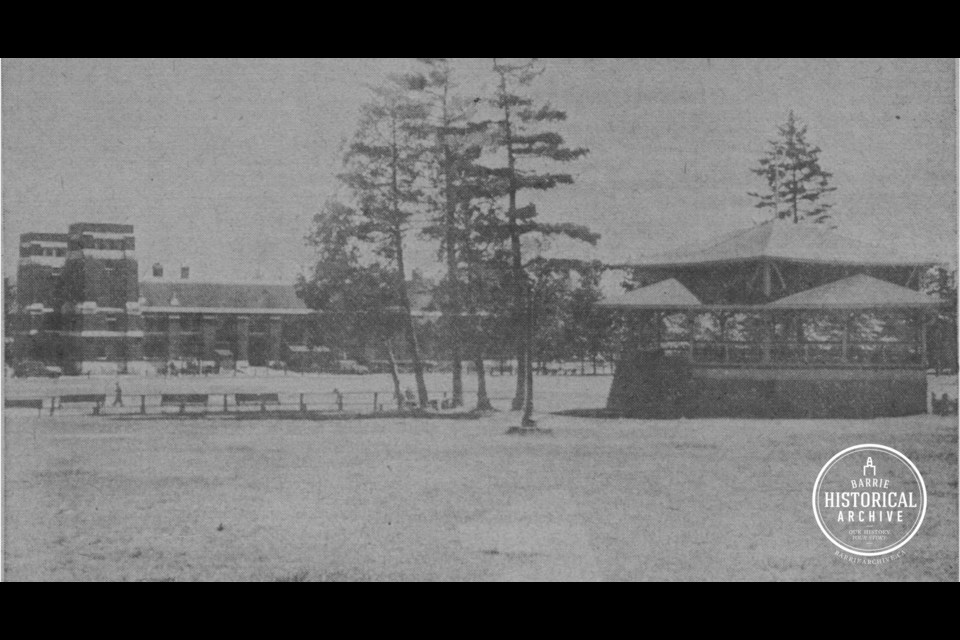This ongoing series from Barrie Historical Archive curator Deb Exel shows old photos from the collection and one from the present day, as well as the story behind them.
Queen’s Park
Archibald ‘Arch’ Thomson was a lumberman, landowner, councilman (1870) and one of Barrie’s first families.
Before moving to Barrie, Thomson and his family lived in Angus, where he ran a lumber business for about 15 years. His large tracts of timber stood where the village of Angus would be built.
Thomson bought the former Eccles property – a large piece of land west of Bayfield Street between Elizabeth Street (now Dunlop Street West) and Wellington Street. His home overlooked the six acres of land he would offer to the Town of Barrie in 1867, for municipal use as well as a location for a drill shed.
The previous year, Lt.-Col. Dennis of the Federal Ministry of Militia had visited Barrie to choose a site for a county battalion drill shed. Although St. Vincent Square had been selected, having the space for not only drills but also a fairground, the drill shed was ultimately built, in 1868, on the six-acre parcel donated by Arch Thomson. The wooden building burned in 1886 and a new drill hall was built on Mulcaster Street two years later.
The rest of the six acres became a public park: Queen’s Park.
The new park, named for Queen Victoria, was bounded on the north side by Ross Street – part of the historic Nile Mile Portage and one of Barrie’s oldest streets. On the east side was Toronto Street, to the south was Park Street, which was named for Queen’s Park, and on the west side was Small Street, which would be renamed Parkside Drive.
Arch Thomson continued to develop his land holdings, laying out the town lots in 1873 that would become Florence Street, named for his eldest girl.
Both of Thomson’s daughters married lumbermen: Florence married James Lindsay and Emma married Martin Burton in 1876. The Burtons’ elegant home resided on Toronto Street on the east side of Queen’s Park. Martin and Emma’s daughter, Olive, would go on to marry Nathaniel Dyment, of the High Street Dyments. When Emma Burton passed away, her funeral was held at Rowanhurst, Olive’s home.
The Thomsons continued to help their community as members of the Presbyterian church, in civic politics, and at social events.
In the summer of 1887, the Barrie Mission Band, with the Barrie Brass Band in attendance, held a promenade concert on the grounds of Mrs. Thomson’s home with a 10-cent admission. When the Barrie General Hospital had outgrown its new location just five years after opening, it was Thomson who offered two-and-a-half acres on Ross Street for only $650 so that a new, larger hospital could be built. The Royal Victoria Hospital opened in 1903.
Queen’s Park, surrounded by hospitals, beautiful mansions, stately homes, churches and shady streets, has seen both growth and gatherings: the construction of a new armoury (1914); a Grand Trunk Railway employee picnic in 1922 with more than 1,000 people; the Kiwanis Club, with the assistance of the St. Andrew’s church organist and choir master, held the first community sing-song in 1923 with 1,200 attendees; 600 school children participated in an organizational meeting of the Just Kids Safety Club in 1928; the Rotary Club built the first wading pool in 1955; and, in 1999, sod was turned for Barrie’s skateboard park.
Countless militia and cadets held drills on the park lawns and many generations enjoyed ball games and the playgrounds in Queen’s Park.
The lands that once belonged to Arch Thomson are now a large part of the Queen’s Park Historic Neighbourhood and we can thank Thomson for giving us its jewel – Queen’s Park.



